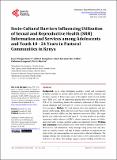Socio-Cultural Barriers Influencing Utilization of Sexual and Reproductive Health (SRH) Information and Services among Adolescents and Youth 10 - 24 Years in Pastoral Communities in Kenya
View/
Publication Date
2018-12-25Type
Article, Journalviews
downloads
Metadata
Show full item recordCitation
Kinaro, J.W., Wangalwa, G., Karanja, S., Adika, B., Lengewa, C. and Masitsa, P. (2019) Socio-Cultural Barriers Influencing Utilization of Sexual and Reproductive Health (SRH) Information and Services among Adolescents and Youth 10 24 Years in Pastoral Communities in Kenya. Advances in Sexual Medicine, 9, 1-16. https://doi.org/10.4236/asm.2019.91001
Abstract/
Background: As in other developing countries, sexual and reproductive ill-health continues to mostly affect adolescents and youths. Samburu and Turkana counties in Kenya have some of the highest levels of total fertility rates (TFR) at 6.3 and 6.9 respectively placing them well above the national TFR of 3.9. Establishing factors that influence utilization of SRH services among adolescent and youth aged 10 - 24 years is critical in developing an effective program. Method: We used primary data from qualitative and purposeful study design. Data collection used Focus group discussions (FGD), In-depth interviews (IDIs) and Key informant interviews (IDIs). The target groups were adolescents and youth aged 10 - 24 years, health care providers, community health volunteers (CHVs), chemist assistants, parents of adolescents and youth, teachers, spiritual leaders and traditional activists. Findings and Conclusion: Socio-cultural factors were found to influence utilization of SRH services and information. Early marriage, being youth, male only decisions on sexuality matters and fear of family contribute to unprotected sex while myths and misconceptions on contraceptives affected utilization. The findings revealed that youth needs to know sources, how contraceptives work and how to use them. The findings suggest capacity building of health care providers, CHVs, teachers, parents and community leaders on adolescence, sexuality needs of adolescents and disadvantages of female genital mutilation (FGM) including early marriage.
Subject/
Adolescents and Youth; Socio-Cultural; Sexuality Information; Service Utilization; Sexual and Reproductive Health
Further Details
Copyright © 2019 by authors and Scientific Research Publishing Inc. This work is licensed under the Creative Commons Attribution International License (CC BY 4.0). http://creativecommons.org/licenses/by/4.0/ Open Access
Publisher
Scientific Research PublishingISSN
Online: 2164-5205; Print: 2164-5191Collections
- General - GEN [367]

